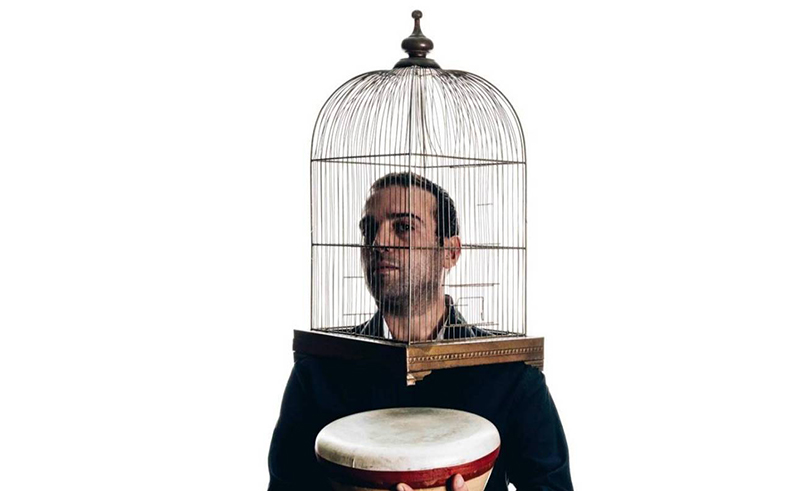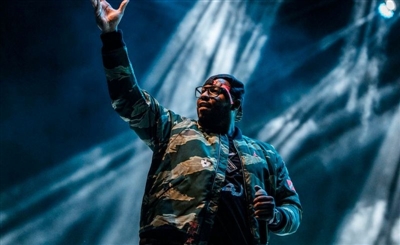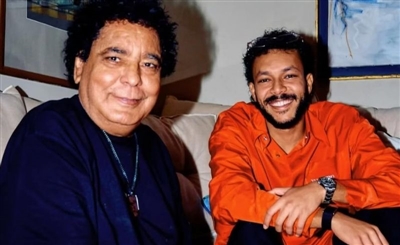Copied
The Whimsical Language of Wassim Halal
The French Lebanese darbuka player draws a myriad of folk influences into the avant-garde laboratory that is his recent album, 'Le Cri du Cyclope'.
Mar 10, 2019

Born in France, Wassim Halal would spend every summer in Lebanon with his family. He first heard the darbuka at Lebanese weddings, near Sarafand, as a child. Following these summers, he would spend the remainder of the year trying to replicate the sounds and techniques he had absorbed in his country of origin. Eventually, this became his calling, and the more advanced he became on his instrument throughout the years, the more he began to experiment with it, carrying it into drastically different new settings than those weddings he had first witnessed it at.
Darbuka is not an instrument generally associated with experimentation. As a rhythm instrument used in traditional accompaniment roles, it has historically been defined and rigid in its scope. While there are several people who have pushed the boundaries of Middle Eastern percussion, it’s rare to find someone guiding a project with such creative audacity and vision as Halal.
<iframe width="560" height="315" src="https://www.youtube.com/embed/IOl87hdwZEA" frameborder="0" allow="accelerometer; autoplay; encrypted-media; gyroscope; picture-in-picture" allowfullscreen></iframe>
The darbuka, a goblet drum used throughout the Middle East, Mediterranean, Balkans and even parts of South Asia, is a staple of the percussive texture of the region. “It’s always included in wedding music, but at the same time, it is often integrated into ‘classical’ Arabic music,” Halal tells SceneNoise. Originally, the body was made of clay, with a skin-head – normally goat. In the 50s, Halal explains, the skin began to be replaced by synthetic material, and the body by aluminum. “Imagine an acoustic violin totally changing its material!” he points out, adding that these days, many people are returning to an interest in the original clay-bodied, animal skin instrument: the alchemy of earth, fauna and wind.
“This instrument is really my passion”, Halal says, explaining that when you go deeper into it, there are two sides of it to be mastered: time and sound. The real challenge however, he says, is being boxed in – he says people in France jump to the conclusion that he is familiar with the ‘darbuka repertoire’, discounting the fact that this encompasses a myriad of traditions. Breaking this box for people, this notion that the darbuka needs to be connected to a folkloric repertoire, is his goal. “How can I let people feel this instrument without it being through the glasses of Orientalism? By discovering the sounds of the material under my hands.”
<iframe width="560" height="315" src="https://www.youtube.com/embed/L1Y3YLH_VTw" frameborder="0" allow="accelerometer; autoplay; encrypted-media; gyroscope; picture-in-picture" allowfullscreen></iframe>
This challenge has been with Wassim since he began studying the darbuka. “The idea of taking my freedom was necessary from the beginning”, he says, but that doesn’t mean that he isn’t well studied and steeped in the traditions of the instrument. In fact, it has acted as a necessary guiding element in Halal’s reclamation of the instrument within his own vision. “I needed to understand the root, to understand the idea of what element I could play with and which one I had to disturb. All codes from popular to classical music became food to this goal.”
His recent album, Le Cri du Cyclope, is a masterwork for those who revel in the intersection of avant-garde and tradition; even more so for those interested in Middle Eastern and Balkan roots. Halal envisioned the album while doing a residency at The Mansion Hub in Beirut, and brought it to fruition with the help of the AFAC Foundation. With this opportunity to make a solo album, he set out to show his instrument’s contemporary potential. Beyond simply pushing the darbuka into uncharted territory, Halal decided to make the album a triptych, meaning it’s organised into three distinct disks.
<iframe src="https://open.spotify.com/embed/album/05WFWic8kIpSNJenqTIPjF" width="300" height="380" frameborder="0" allowtransparency="true" allow="encrypted-media"></iframe>
In Disk 1, the darbuka is the focal point, while the melodic instruments are meant to form a sonic texture, perceived by the listener as more of a watermark than a point of focus. Halal calls them “phantom limb melodists.” On this disk, Halal plays not only the darbuka, but also the doholla and daf. Wasting no time, the first track, ‘L’oracle’, launches us straight into the fray, with ear-curdling, high-pitched zurnas and mizmars. This track, acting as an intro, features nearly every musician featured on the rest of the album – but no drums. The next track, ‘Au son des tambours’, changes this, breaking violently into furious rhythm.
Disk 2 is focused on polyrhythms. Halal instructed the melodists to imitate the darbuka, while adding their own melodic touch within the realm of the possibilities of their instruments. The first track, ‘Rêve de Polyphème’, is a direct foray into Balinese gamelan music, with the guest melodists playing reyong, an instrument made of a long row of metal gongs. Other melodic instruments on the disk include clarinet, saxophone, violin and cello.
In Disk 3, the final disk, a set of compositions converge, the main components being drones, vocals and rhythm. The buzzing of drone instruments, such as the mizmar, zurna and bagpipe, bombard the listener. ‘Dernière incantation’ is a stand-out track on the disk, intense and haunting, and features one of the crucial voices of Egyptian music – Gamalat Shiha – who passed away last year.
<iframe width="560" height="315" src="https://www.youtube.com/embed/xoQ21M4TlG8" frameborder="0" allow="accelerometer; autoplay; encrypted-media; gyroscope; picture-in-picture" allowfullscreen></iframe>
Halal’s approach to melody on the album was very holistic. Rather than proposing specific melodies, he asked the guest musicians to “imitate the darbuka’s logic,” and from there, build organically and improvise on the roots he had laid out. “Most of the time I had an idea of how a meeting between different guest musicians could sound,” he recalls. “I gave them the idea of what colour I wanted, and on what to put emphasis, and then improvise on some elements.” Phenomenally, he only had one day before recording – sometimes even during the same day – to rehearse with the musicians. Luckily, he “had a lot of confidence in their improvising.”
While at first this sounds like a highly unrealistic and daunting concept, it was Halal’s capacity to accommodate the guests’ specific talents, and mould them to fit his overall vision, that brought the album to fruition. “If you ask Gamalat Shiha to improvise in a contemporary Western style, it won’t work. But if you ask someone to play/sing what they are good at, there is no problem. Sometimes I explained to people what I wanted to do with them, and sometimes I just gave them a feeling without telling them a precise idea.”
<iframe width="560" height="315" src="https://www.youtube.com/embed/gfkZapUVPj4" frameborder="0" allow="accelerometer; autoplay; encrypted-media; gyroscope; picture-in-picture" allowfullscreen></iframe>
This album was recorded at Makan, the staple cultural center located in Cairo’s Mounira neighborhood. “Recording at Makan was so great,” Halal says. “After some police checks at the airport, we arrived and recorded directly with one of the best mizmar players, Aala Samir, then Mazaher Ensemble, and my hero, Gamalat Shiha”. Meeting and recording with the legendary Gamalat Shiha – a regular performer at Makan, heralded as “The Soul of Egypt” – was extraordinary for Halal and his colleagues. This was one of – if not the – last recordings before her death, which came to her at the ripe age of 85. According to Halal, though no less powerful in voice, her age was showing in her hearing. “Her ears were a bit tired, so even if the oud player was just tuning his instrument, she would think that the music had started, and would begin singing mawwal.” Halal soon hopes to organise a concert around the album at Makan.
Le Cri du Cyclope is bizarre, compelling and impressive. It is also difficult. But Halal didn’t set out to make an easy record – he wanted it to be intimate, so intimate that he would “invite the listener into my head, to understand what I like, and to evolve with me throughout the stream of the album.” Encompassing influences that include, but are not limited to, gamelan, Turkish Roman (Gypsy), Balkan brass, zar, mawwal, free jazz, and classical, the album manages to highlight the individual talents of a multitude of musicians, urged by Halal’s intention to allow the music to sprout, crawl, writhe, snarl, and blossom of its own accord, watered by the rhythmic undercurrent he has laid down, the current that unites the many influences. One can spend a long time unpacking this record, and that is a good thing – the landscape of Halal’s mind is a very peculiar and fascinating place, worth that time.
Album artwork by Benjamin Efrati & Diego Versatgui.
- Previous Article Getting Abyusif
- Next Article 23 Must-Watch Middle Eastern Music Documentaries
Trending This Month
-
Dec 15, 2025






















